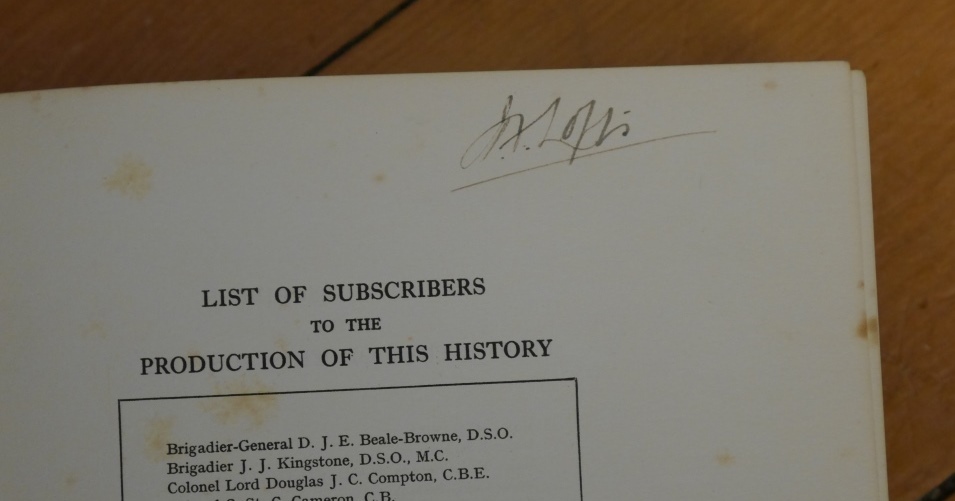I have a considerable family connection with the 9th Lancers, one of the most historically interesting of the British cavalry regiments – my maternal grandfather Tom Verrinder and his brother Edgar served with the regiment during the First World War, and on my father’s side my great-great uncle Major Edward Robertson Gordon was with the regiment during the Boer War, commanding it briefly in 1901 (and co-authoring the Diary of the 9th (Q.R.) Lancers during the South African Campaign, 1899-1902). Edward's uncle William Cracroft Gordon was an officer with the regiment in India during the 1850s, as was his nephew John Gordon in Italy towards the end of the Second World War.
While researching these men I acquired a fine copy of the regimental history, The 9th Queen’s Royal Lancers 1715-1936 by Major E.W. Sheppard (Gale and Polden, 1939), signed ‘J.F. Lofts’ and accompanied by a First World War era regimental cap badge. Private J.F. Lofts is mentioned in the book for receiving the Military Medal - a gallantry award for enlisted men - following the regiment's involvement in repelling the German Somme offensive in Spring 1918; the award is also noted in the regiment's War Diary, seen in the image below, in the gallantry award medal index card in the UK National Archives (WO 372/23) and in the London Gazette for 16 July 1918. The National Archives also hold his Medal Card for his three campaign medals, showing that his name was John and noting that he arrived in France on 1 June 1915 and was discharged to the army reserve on 6 May 1919.
Taped into the front cover of the book was the photo reproduced above, showing six men inside a stable block, one of them (not the Lance-Corporal) presumably Private Lofts. Because the building is a permanent stable block this photo is most likely to have been taken during his period of cavalry training in England, probably at Tidworth in Wiltshire, the main cavalry training depot, prior to his departure to France in mid-1915. My grandfather’s training during the following year took place over a five-month period at Tidworth, and included much focus on grooming and looking after horses as depicted in this photo.
The period of action for which Lofts received his M.M., during the German Somme offensive in March-April 1918, is described at length in the regimental history as well as the 9th Lancers’ War Diary. From the start of the offensive on 21 March until the tide was turned in early April the regiment was continuously involved in front-line action, a period my grandfather remembered for the Germans coming in their thousands as ‘point-blank targets.’ The specific circumstances of Lofts’ award are unknown, but he was one of eight men of the regiment to be decorated after the battle, ‘no more – perhaps somewhat less – than its deserts,’ according Major Shepperd in the regimental history. The regiment lost 33% of its fighting strength during the battle including 58 men killed, the largest loss during one battle among the 296 men of the regiment recorded by the Commonwealth War Graves Commission as being killed during the war.
The London Gazette citation, shown below, notes Private Lofts's home town as Bury St Edmunds, meaning that he is very probably the John F. Lofts listed in the 1901 Census as the nine-year old son of Emma J. and Robert Lofts, a house decorator of that town. The Births, Marriages and Deaths Index lists a John Francis Lofts as born in the fourth quarter of 1891 in Bury St Edmunds, and the England and Wales Death Index for October 1974 includes a John Francis Lofts of Bishop's Stortford, Hertfordshire, who was born on 10 October 1891. The 1911 Census shows a John Francis Lofts of the right age as a bank clerk in Cambridge, and Kelly's Directory shows a man of that name living in Bishop's Stortford by 1926. All of these references can be found by searching his name on ancestry.co.uk.
Entry in the 9th Lancers War Diary of 25 April 1918 showing the award of the Military Medal to Private J.F. Lofts (UK National Archives, WO 95/1113/2).
Medal Card of Private J.F. Lofts showing the award of the three campaign medals (Victory Medal, War Medal and 1915 Star), his date of first arrival in France of 1 June 1915 and his transfer to army reserve ('Class Z') on 6 May 1919 (UK National Archives, WO 372/23/134514).
An image from the London Gazette of 16 July 1918 showing 6876 Pte J.F. Lofts in the list of Military Medal recipients, and showing his home town as Bury St. Edmunds.







